Giving it the beans along Big Tujunga Highway in Southern California’s Angeles National Forest, this 2024 Ford Mustang EcoBoost feels familiar but different. Dynamically, the seventh-generation Mustang doesn’t change much, but it has a lot more technology to experience behind the wheel.
The seventh-generation Mustang, known internally as S650, is little different than the last-generation S550 version.
That’s alright because we felt the S550 generation Mustang graduated from pony car to sports car, especially with the 2018 update that better sorted out the independent rear suspension added with the debut of the S550 for the 2014 model year.
2024 Ford Mustang EcoBoost
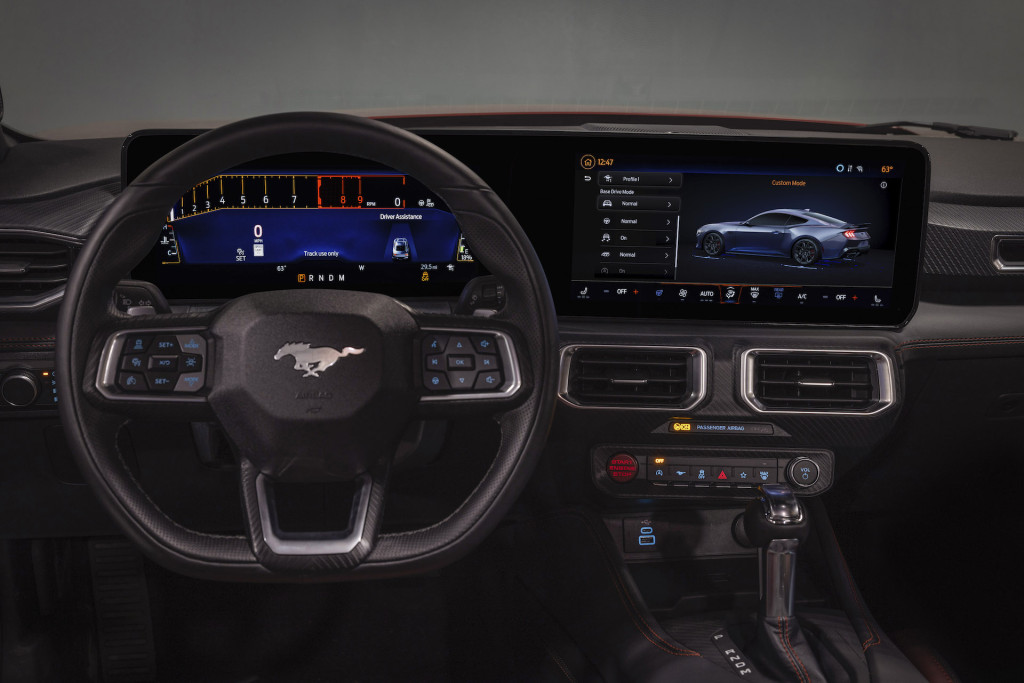
2024 Ford Mustang Track theme and Custom mode screen
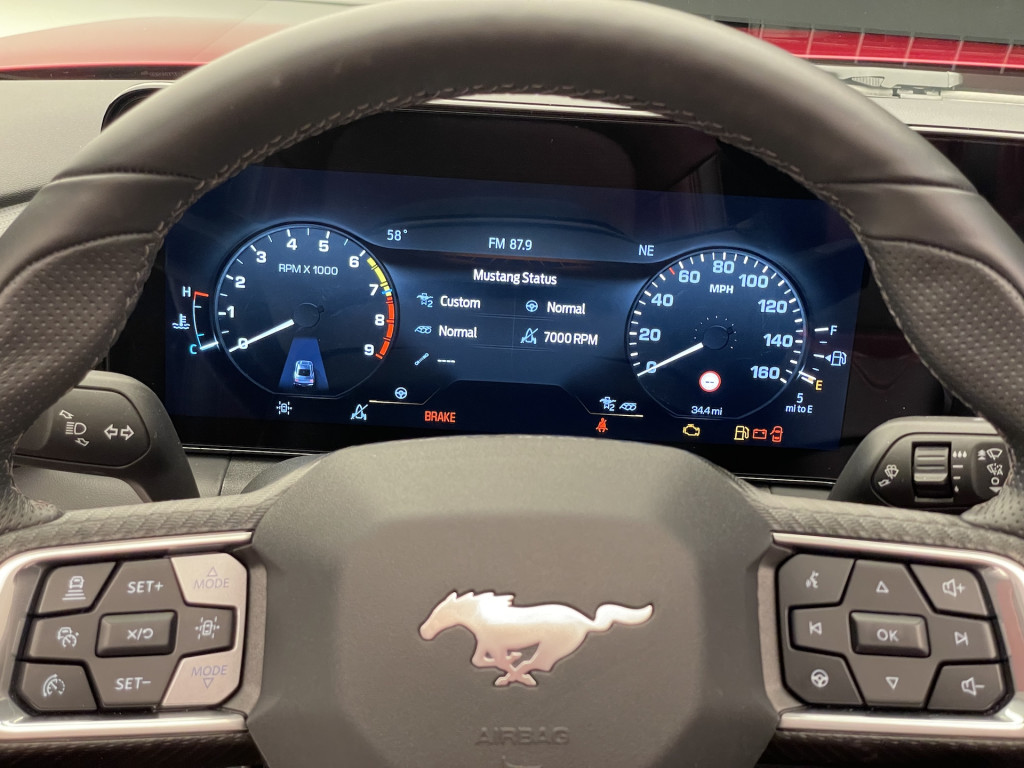
2024 Ford Mustang Fox Body ’87-’93 theme
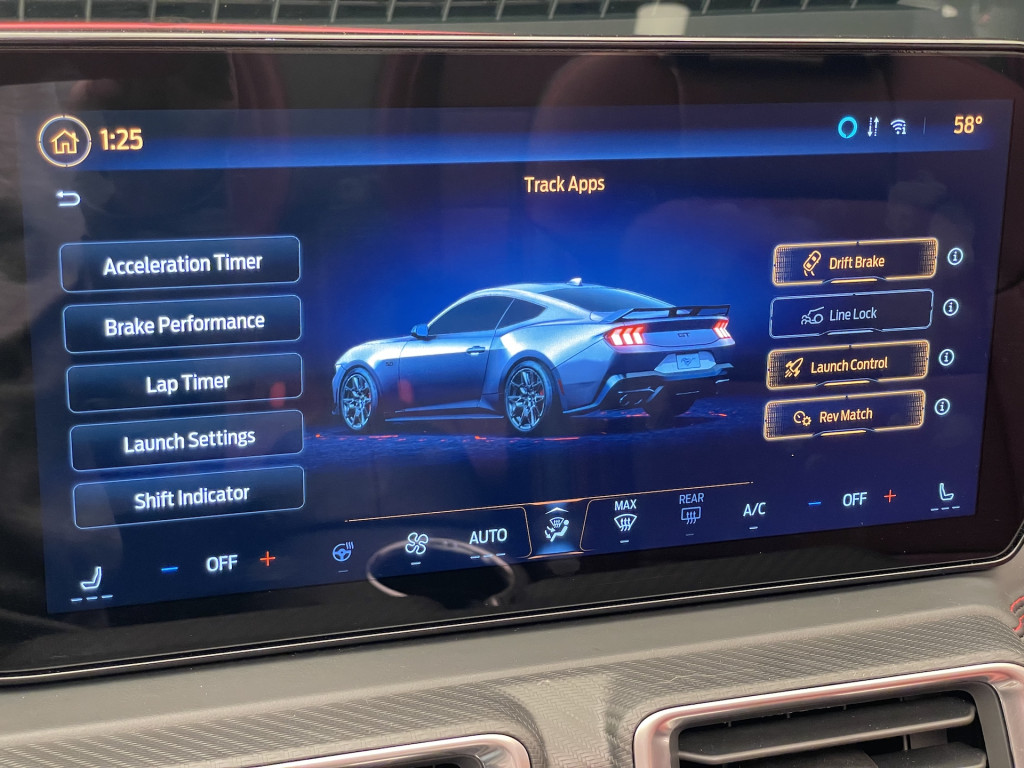
2024 Ford Mustang Track Apps
2024 Ford Mustang: Screens galore
The 2024 Ford Mustang sports a new exterior design that reads as an evolution of the S550 with a touch of Chevrolet Camaro thrown in, especially in the more pronounced rear haunches. The big change, however, comes inside, where the traditional double-binnacle instrument cluster gives way to a bank of screens that serves as more than just a tech hub.
A 12.4-inch digital instrument cluster and a 13.2-inch touchscreen spread out in front of the driver in juxtaposition to a cabin that otherwise has retro influences. The Sync 4 infotainment system has twice as much processing power as the last car’s Sync 3 system, and the screens use Unreal Engine graphics that serve as the backbone for many popular first-person-shooter video games. The system can be updated over the air automatically or on a schedule.
I ran through the many features of the system after a preview at Ford headquarters in March, but now I’ve experienced it and can say it adds to the overall Mustang experience. The instrument cluster can be set to the driver’s choice of five themes: Normal, Sport, Track, Fox Body ’87-’93, and Calm. The Track theme depicts a hockey stick tachometer like you see on many supercars, Sport mode has curved speedometer and tachometer graphs that sweep up from the bottom, and Fox Body digitally represents the analog gauges from the latter years of the third-generation Mustang.
I’m driving with the Fox Body theme because, well, you gotta give props to the Mustangs that inspired Vanilla Ice to roll in his 5.0, don’t you?
For the most part, the cluster themes match the drive modes, though there is no Calm drive mode (as there shouldn’t be in a Mustang), and Ford also adds Drag Strip, Slippery, and programmable Custom modes. Every Mustang has every drive mode, giving even the relatively tame EcoBoost a toybox of performance features to choose from.
It’s all easily accessed via the MyMustang button on the center stack, which brings up a screen that lets drivers program the custom drive modes, display auxiliary gauges, choose from four sound settings for the available active exhaust, pick a cluster theme, set the ambient lighting color, and most importantly, access the Track Apps performance features.
The Track Apps let drivers monitor telemetry including braking distance and acceleration and lap times. This is also where drivers activate the launch control, the line lock, the new electronic parking brake Ford calls the Drift Brake, and in the GT with the manual transmission, the rev matching feature.
But this is a lightly equipped EcoBoost model and I’m driving with a journalist who gets carsick. He’d likely heave if I tried those features, so I’ll save the sophomoric fun for a GT with the Performance Package.
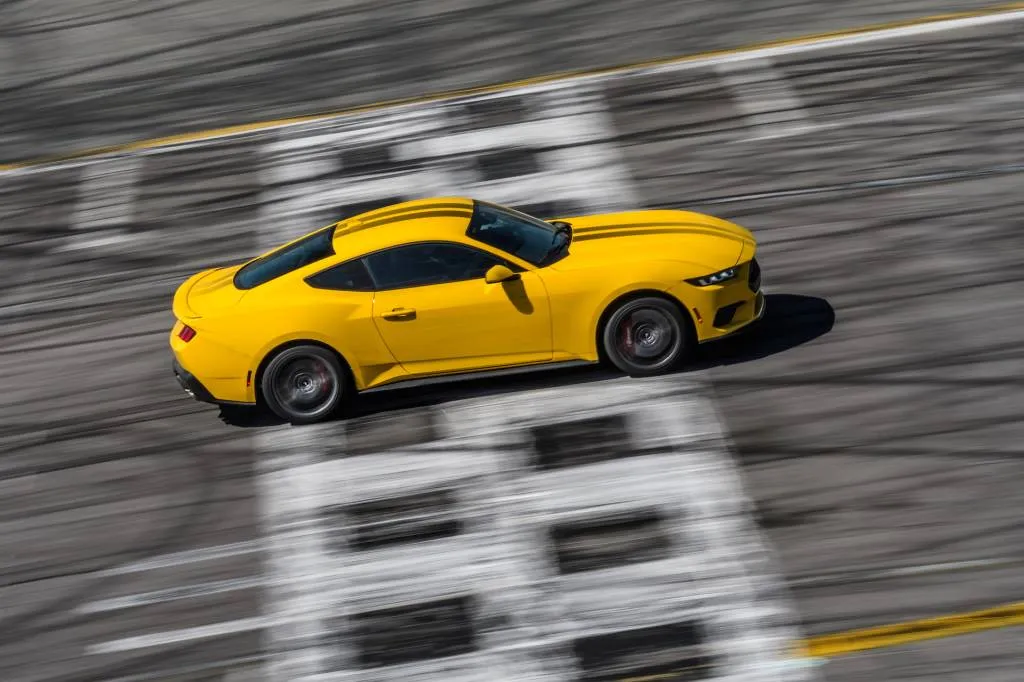
2024 Ford Mustang EcoBoost
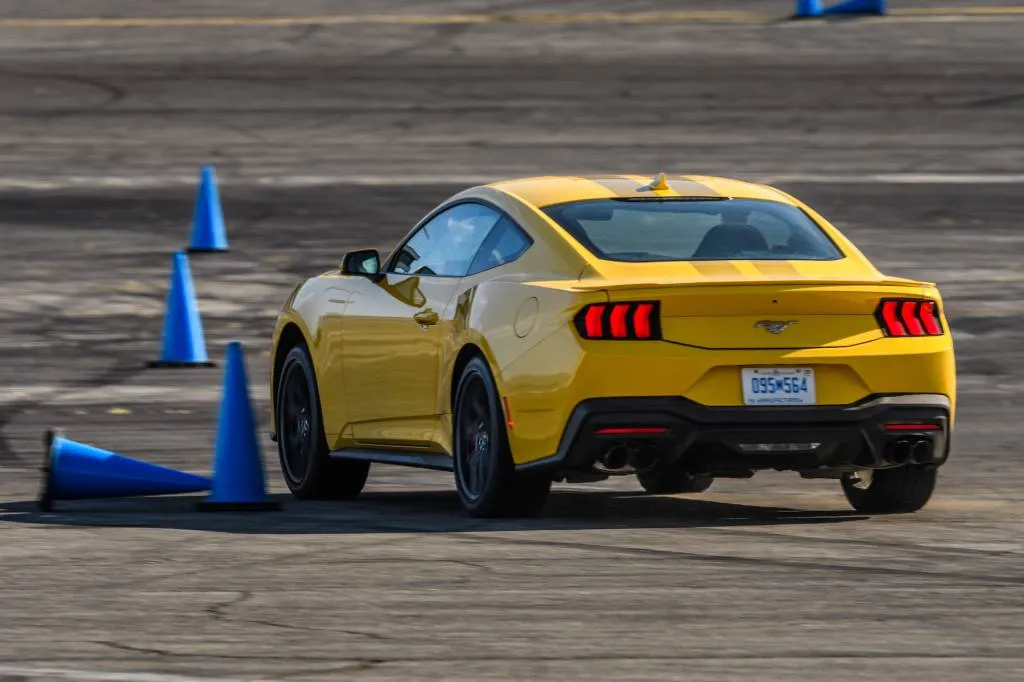
2024 Ford Mustang EcoBoost
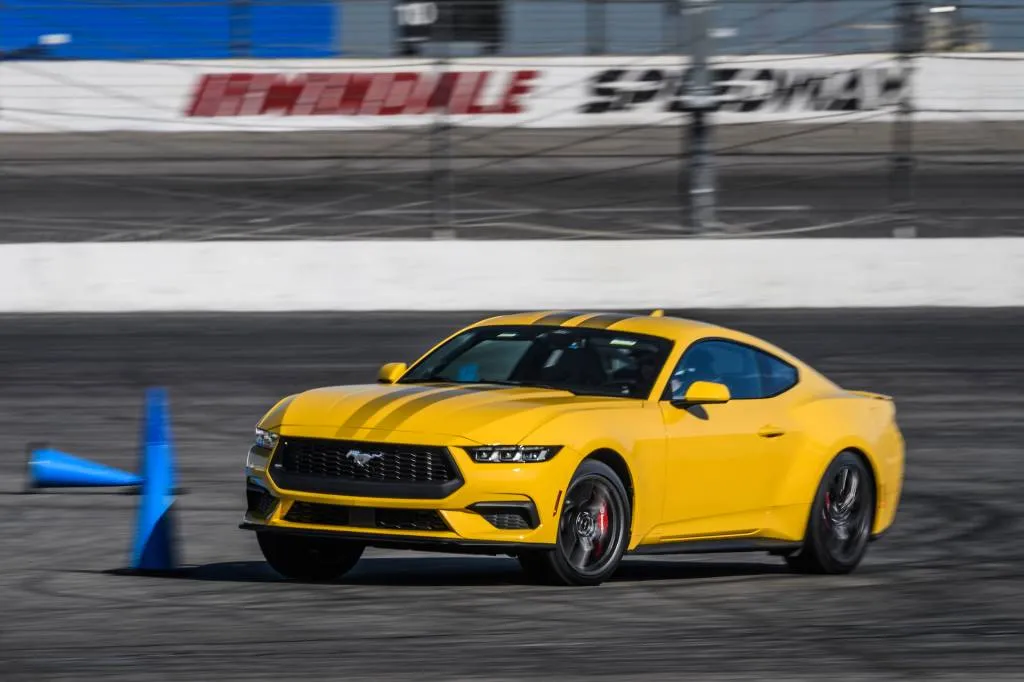
2024 Ford Mustang EcoBoost
2024 Ford Mustang EcoBoost: Sorted and controlled
While not as overt as the new Mustang’s tech suite, the mechanical changes are mostly for the better, but it all starts with the same stiff and well-sorted platform as the previous car.
The steering is the most notable dynamic difference. The steering column is stiffer, a rubber bushing has been removed for a more direct feel, and the ratio has been slightly quickened from 16.0:1 to 15:5.1. The idea was to provide quicker responses (marginally) and more road feel. Along the way, Ford also lightened the steering weight, and I’m finding it too light on these canyon roads as it’s requiring too many little corrections. I’m in Sport mode, which has a heavier “sport” feel, too. The choices here appear to be light, lighter, and lightest. I wish Ford would add a setting that makes the wheel more stable.
I’m in an EcoBoost Premium model with a square set of 255/40R19 Continental ProContact all-season tires. This car has none of the available performance goodies, such as the $1,750 magnetic dampers or the $3,475 Performance Package that adds Pirelli P Zero PZ4 summer-performance tires, a strut tower brace, a larger rear sway bar, a 3.55 Torsen limited-slip rear axle, the Drift Brake, heavy-duty front springs, larger brakes with front Brembo calipers, paddle shifters, and a rear wing spoiler.
Left with the basics of the Mustang’s rear-wheel-drive architecture, the car is performing well here. Despite the lack of steering weight, the car reacts promptly to steering inputs and the wheel is telling me what’s happening at road level. The tires provide enough grip that I’m not sliding through the corners, even during an especially spirited six-mile stretch through the twisties during which my drive partner is waiting at a rest stop.
As I approach the corners, the car’s base brakes—a set of four 12.6-inch rotors with two-piston front calipers and single-piston rear calipers—stand up surprisingly well. The brake pedal has a sturdy and progressive feel, and it keeps the same resistance throughout my drive. I can’t leave him sitting there to wring it out for extended periods of time, and I wouldn’t trust these brakes in that situation or on a track, but they’re more than up to the punishment expected of Mustang buyers who would choose a base suspension.
Like other Mustangs, this car rides on new dampers, but they’re tuned for little change in behavior versus those of the S550 model. In each configuration, they’re just optimized for the new steering, as well as the chosen tire and brake package.
The dampers help control body lean well and contribute to a firm ride that also provides plenty of road feedback but never crosses over into harsh. It’s all tied together well, with good handling balance in the corners. Yes, you can kick out the rear end, but it requires a concerted effort and/or use of the Drift Brake (more on that later).
I can hear plenty of tire hum on these rough roads, though the cacophony of sounds is part of the Mustang experience. The tire noise isn’t all that noticeable because a next-generation 2.3-liter turbo-4 under the hood has plenty to say. It belts out a mezzo-soprano tune that is at times authoritative, coarse, and droning. It’s always spirited, though, and that fits with the Mustang’s extroverted character.
The engine is the fourth generation of the 2.3-liter turbo-4 that Ford almost comically calls EcoBoost (maybe the “Eco” part it was more relevant 14 years ago when EVs were barely a thought in the automotive industry and when a DOE loan went toward downsizing and turbocharging Ford engines). Changes this time around give it more power while also making it more efficient. It gets a new twin-scroll turbocharger that scrolls up quicker. It also adds port injection to the existing direct injection for improved power and fuel economy. The changes boost output slightly, adding 5 hp for a total of 315 hp and keeping torque steady at 350 lb-ft.
I look at the 2.3 as a fine consolation prize in the Mustang. It’s perfectly capable and it gets the job done with a little flair, but I’d rather win the showcase showdown is the Coyote 5.0-liter V-8 in the GT models.
I feel the same way about the fact that the EcoBoost is paired only with the 10-speed automatic—it’s a fine transmission but not as much fun as the 6-speed manual that was available in the outgoing EcoBoost.
The powertrain also performs well in these hills. Sport mode generally keeps revs high, and Track does an even better job to make the power readily available at corner exit. Track sometimes downshifts mid-corner, slightly affecting the car’s balance. It’s not enough to disrupt my line, but using the paddle shifters would help prevent it, though they only come with the Performance Package. The car picks up speed steadily from curve to curve. It’s quick and spirited, with a 0-60 mph time in the low-to-mid five-second range, but it’s not the hammer that the V-8 is.
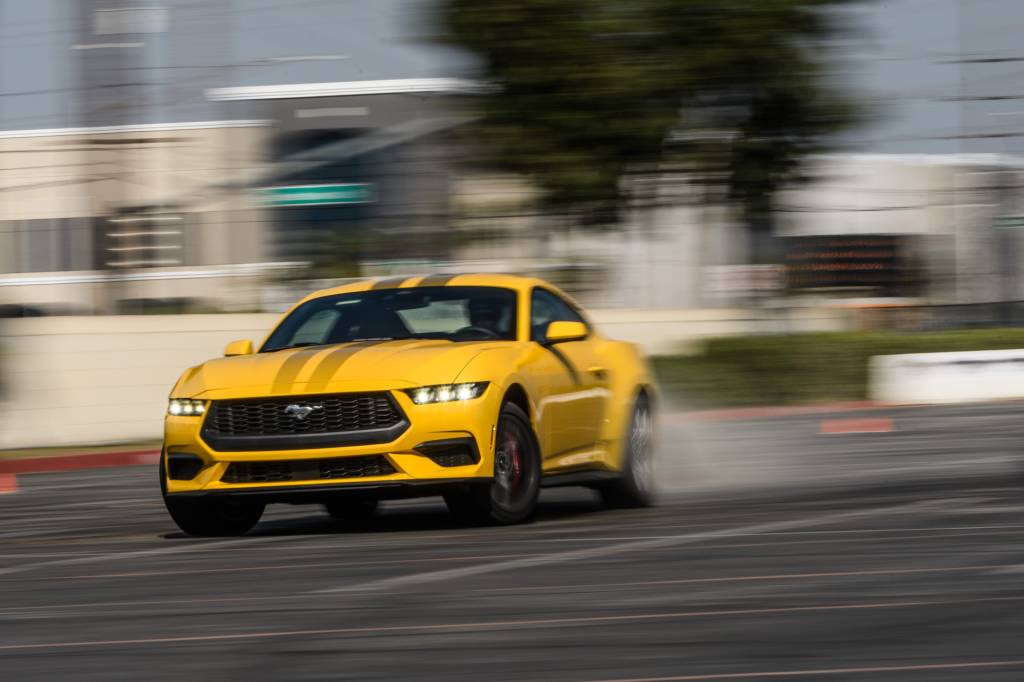
2024 Ford Mustang EcoBoost
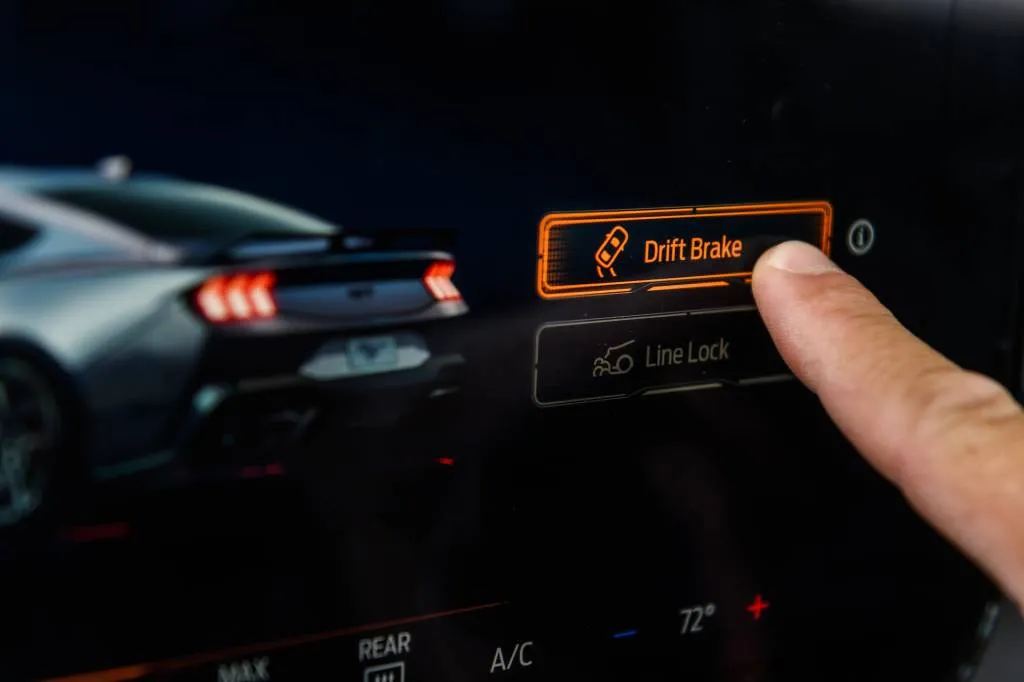
2024 Ford Mustang EcoBoost
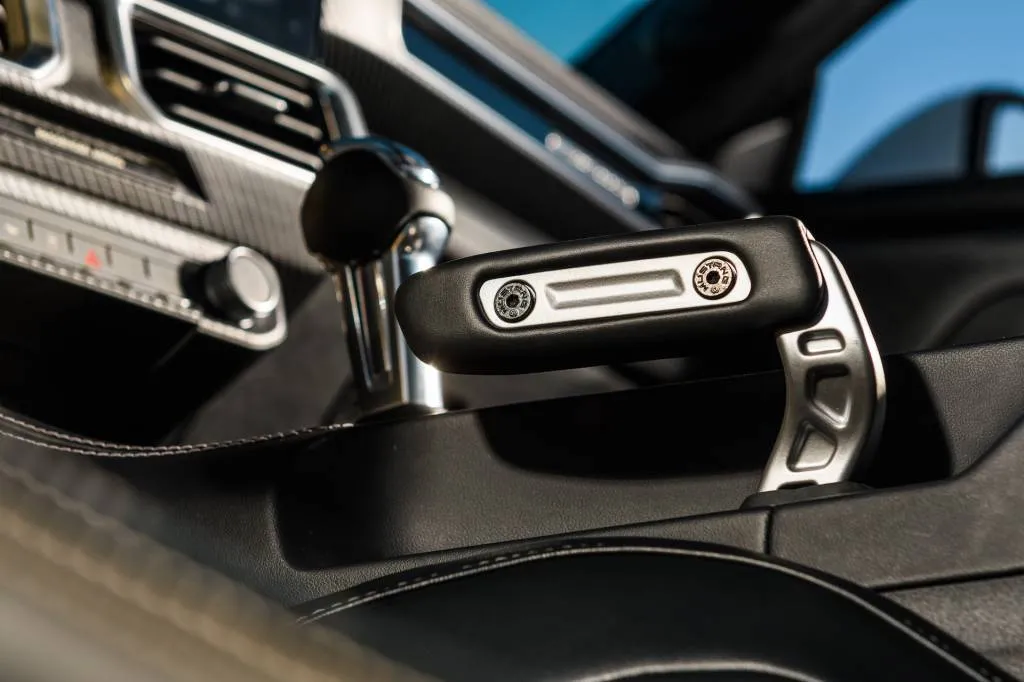
2024 Ford Mustang EcoBoost
2024 Ford Mustang EcoBoost: Drifting made easy
Earlier in the day, I had the opportunity to test one of the new Mustang’s party tricks: the Drift Brake it developed with pro drifter Vaughn Gittin Jr. Included with the Performance Package on either the EcoBoost or GT, the Drift Brake is essentially a fancy electronic parking brake that has more than just on and off settings. Like a manual parking brake, it applies more braking power to the rear wheels the harder you pull the handle. That handle stands up from the center console and has an elbow shape for easy access by the driver.
Ford’s controlled exercise to test the Drift Brake is as rudimentary as possible. It consists of a single 180-degree turn and a perpendicular slide into a stop box.
An instructor shows me the proper technique to induce and then control the car through the switchback turn. It’s similar to a Scandinavian flick and it goes like this: veer left, steer slightly right to send the momentum in that direction, pull the brake, hit the throttle and release the brake at the same time to induce the drift, stay on the throttle until you’re about to be pointed the opposite direction, let up and drive out.
That’s all much easier said than done, and it’s easy to screw up at several points. Veering left is easy, but it’s also easy to steer too far to the right and make the car spin instead of drift. This is exacerbated by my other issue: forgetting to release the brake when I get on the gas. That just leads to a roughly 240-degree spin that stops me pointed the wrong way. I get 10 cracks at it and do it right perhaps twice, and on a third occasion I do a complete 540 that makes me feel pretty cool—though I think it annoys the instructor.
The technique for the 90-degree stop is as simple as steering slightly right to set the momentum and pulling the brake. Again, however, it’s easy to over-steer and over-rotate. It’s the kind of maneuver that can look cool in a TikTok video, but it’s not a wise way to park, especially if other cars are around.
Nonetheless, with regular parking brakes becoming a thing of the past, the Mustang’s Drift Brake brings a bit of forgotten fun back into the car. It can also be used like a normal parking brake. Simply stop the car, pull the handle, look for the “Brake” light on the instrument cluster, and shut off the car. When you start it again, push down on the handle to release the brake.
The Drift Brake is just one way the 2024 Ford Mustang marries tech with performance, and the big new screens are more overt. It all synthesizes with the controlled competence of the largely carryover platform to bring a pony car icon into the modern day without losing its sporty essence. When you can, give it the beans.
Ford paid for travel and lodging for Motor Authority to bring you this firsthand report.
